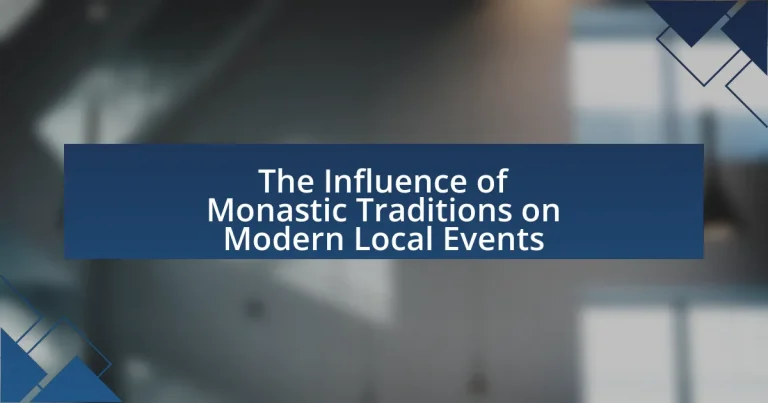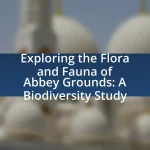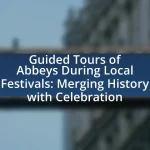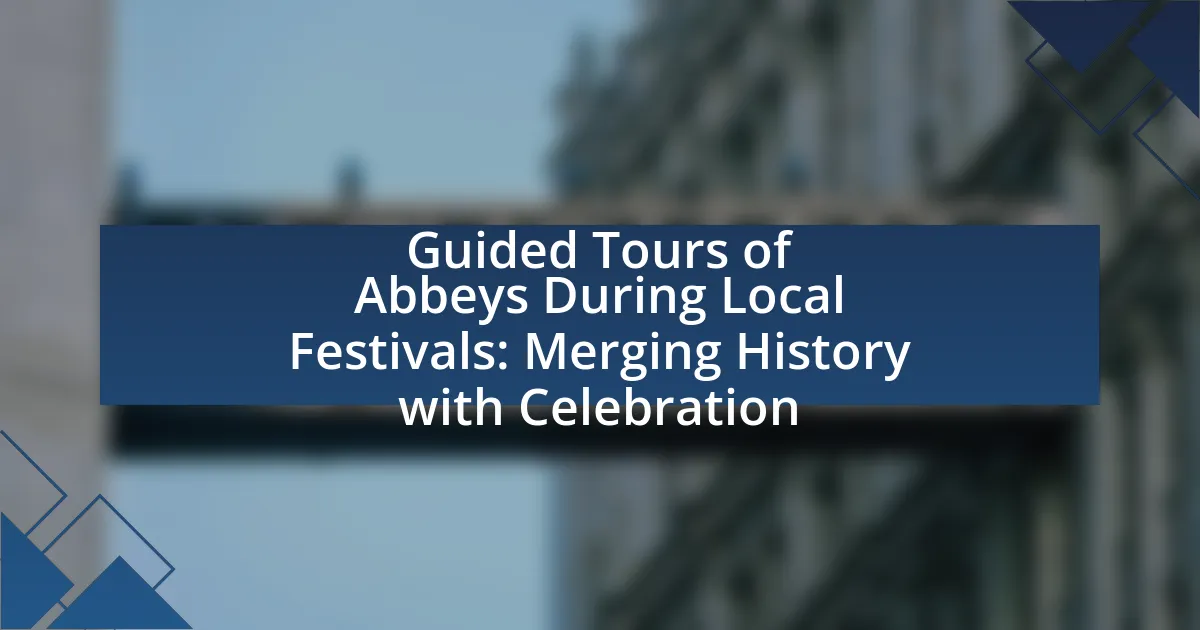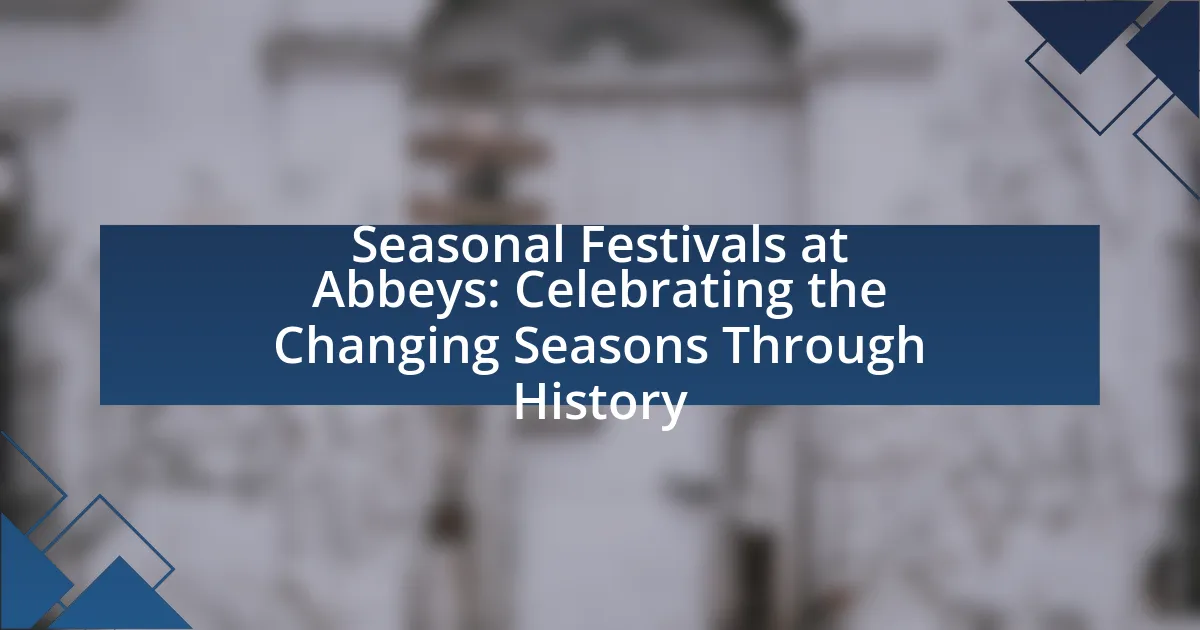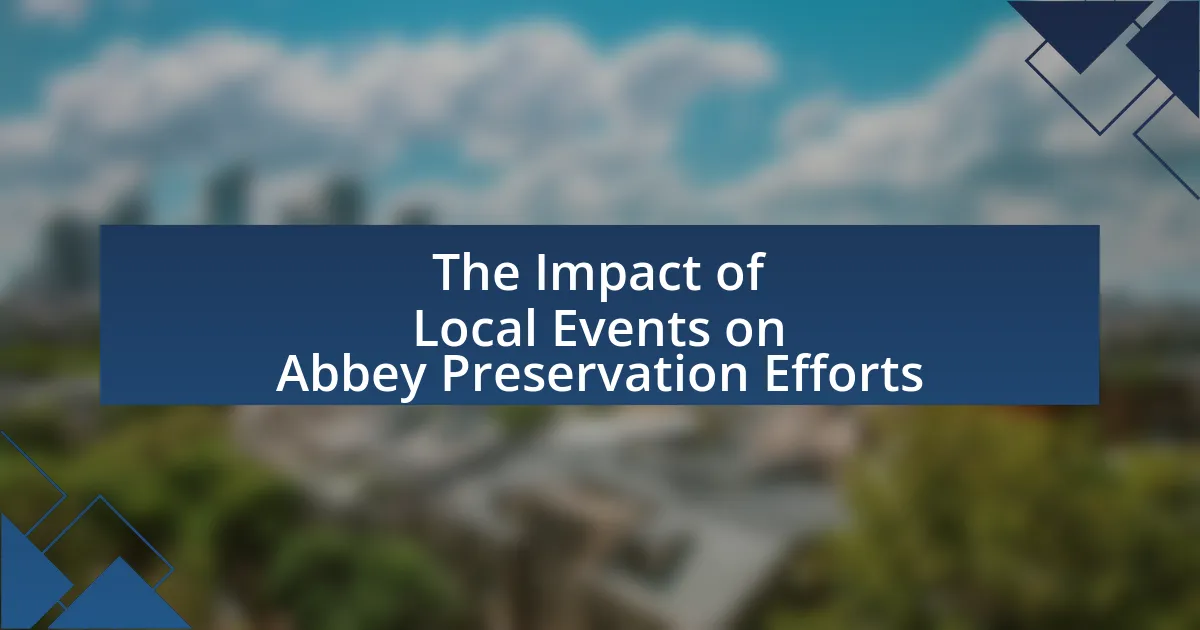Monastic traditions, rooted in communal living and spiritual devotion, have significantly influenced modern local events across various cultures. This article explores the historical context of monasticism, its evolution over time, and the key events that shaped its practices. It examines how different cultures interpret these traditions and their relevance in contemporary society, particularly in fostering community engagement and ethical practices. Additionally, the article highlights the challenges and opportunities of integrating monastic values into local events, showcasing their impact on community cohesion, volunteerism, and cultural preservation.
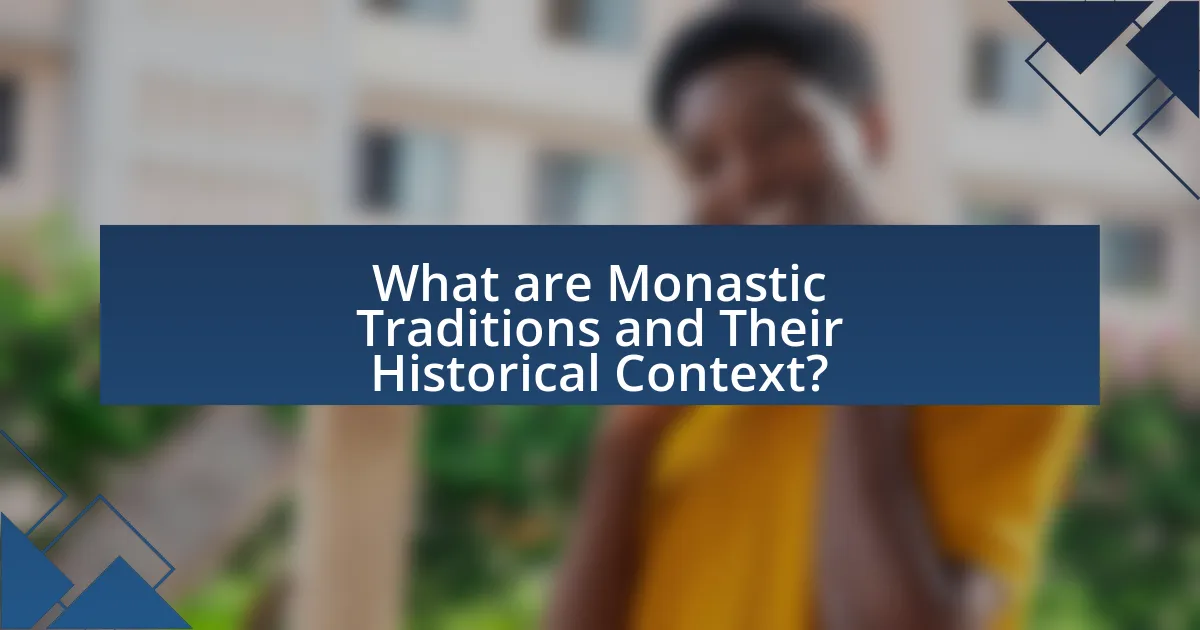
What are Monastic Traditions and Their Historical Context?
Monastic traditions are religious practices and lifestyles characterized by communal living, asceticism, and devotion to spiritual goals, primarily found in Christianity, Buddhism, and Hinduism. Historically, these traditions emerged in the early centuries of their respective religions, with notable examples including the establishment of monastic communities by St. Benedict in the 6th century in Christianity and the formation of the Sangha in Buddhism around the 5th century BCE. These communities served as centers for spiritual learning, preservation of texts, and social services, influencing local cultures and economies. For instance, Benedictine monasteries contributed to agricultural advancements and education in medieval Europe, while Buddhist monasteries played a crucial role in the spread of literacy and art in Asia.
How have monastic traditions evolved over time?
Monastic traditions have evolved significantly over time, transitioning from isolated communities focused on asceticism to more engaged institutions that influence social, cultural, and educational spheres. Initially, monasticism emerged in the 3rd century with figures like St. Anthony in Egypt, emphasizing withdrawal from society for spiritual growth. Over the centuries, monastic orders such as the Benedictines and Franciscans adapted to societal needs, establishing schools, hospitals, and agricultural practices that contributed to local economies. By the Middle Ages, monasteries became centers of learning and preservation of knowledge, influencing the development of universities. In modern times, many monastic communities have embraced social activism and interfaith dialogue, reflecting contemporary values while maintaining their spiritual foundations. This evolution illustrates how monastic traditions have continually adapted to meet the changing needs of society while preserving their core spiritual missions.
What key historical events influenced the development of monastic traditions?
Key historical events that influenced the development of monastic traditions include the establishment of the Rule of St. Benedict in the 6th century, which provided a structured framework for monastic life, and the spread of Christianity throughout Europe, particularly during the Carolingian Renaissance in the 8th and 9th centuries. The Rule of St. Benedict emphasized community living, prayer, and work, shaping monastic practices that became foundational for Western monasticism. Additionally, the patronage of monasteries by rulers and the Church during the Middle Ages facilitated their growth and influence, leading to the establishment of significant monastic orders such as the Cistercians and Franciscans. These events collectively contributed to the institutionalization and diversification of monastic traditions across Europe.
How do different cultures interpret monastic traditions?
Different cultures interpret monastic traditions through unique lenses shaped by their historical, spiritual, and social contexts. For instance, in Buddhism, monasticism is viewed as a path to enlightenment, emphasizing meditation and community living, which is evident in the Theravada and Mahayana traditions. In Christianity, monasticism is often associated with asceticism and communal worship, as seen in the Benedictine and Cistercian orders, which focus on prayer and service. Additionally, in Hinduism, monastic traditions like those of the Sannyasis prioritize renunciation and spiritual knowledge, reflecting the diverse approaches to spirituality across cultures. These interpretations influence local events, such as festivals and rituals, showcasing the integration of monastic values into community life.
Why are monastic traditions significant in contemporary society?
Monastic traditions are significant in contemporary society because they provide a framework for spiritual growth, community living, and mindfulness practices that resonate with modern individuals seeking meaning and connection. These traditions often emphasize values such as simplicity, contemplation, and service, which can counterbalance the fast-paced, materialistic nature of contemporary life. For instance, many people today engage in mindfulness and meditation practices rooted in monastic teachings, which have been shown to reduce stress and enhance well-being, as supported by research from the American Psychological Association indicating that mindfulness can lead to improved mental health outcomes. Additionally, monastic communities often serve as centers for social justice and environmental stewardship, influencing local events and initiatives that promote sustainability and community engagement.
What role do monastic traditions play in local communities today?
Monastic traditions play a significant role in local communities today by providing spiritual guidance, fostering community service, and promoting cultural preservation. Monasteries often serve as centers for meditation, education, and social outreach, which strengthens community bonds. For instance, many monastic communities engage in charitable activities, such as food distribution and healthcare services, addressing local needs and enhancing social welfare. Additionally, monastic traditions contribute to cultural heritage through the preservation of art, music, and literature, which enriches the local identity. Research indicates that communities with active monastic institutions report higher levels of social cohesion and volunteerism, demonstrating their positive impact on local dynamics.
How do monastic values influence modern ethical practices?
Monastic values significantly influence modern ethical practices by promoting principles such as simplicity, community, and mindfulness. These values encourage individuals and organizations to prioritize ethical decision-making, foster social responsibility, and cultivate a sense of interconnectedness. For instance, the emphasis on simplicity leads to sustainable practices in business, as seen in the rise of minimalism and ethical consumerism, where consumers prefer products that are environmentally friendly and socially responsible. Additionally, the monastic focus on community inspires collaborative efforts in social justice initiatives, reflecting a commitment to the common good. Research indicates that organizations adopting these values often report higher employee satisfaction and engagement, demonstrating the practical benefits of integrating monastic principles into contemporary ethical frameworks.
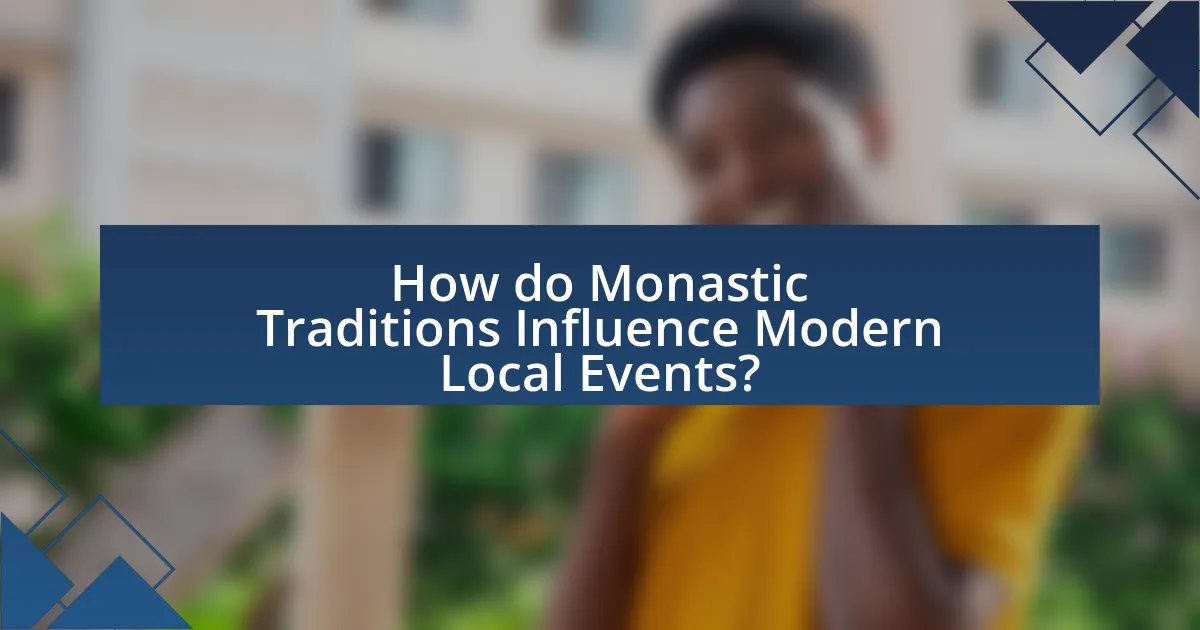
How do Monastic Traditions Influence Modern Local Events?
Monastic traditions influence modern local events by providing a framework for community engagement, spiritual practices, and cultural preservation. These traditions often manifest in local festivals, retreats, and educational programs that draw on historical monastic practices, such as meditation, communal meals, and artistic expressions. For example, many communities celebrate events like the Feast of St. Benedict, which emphasizes hospitality and community service, reflecting the values of monastic life. Additionally, monasteries frequently serve as venues for workshops and events that promote mindfulness and sustainability, aligning with contemporary interests in wellness and environmental stewardship. This integration of monastic principles into local events fosters a sense of continuity and connection to cultural heritage, enhancing community cohesion and spiritual growth.
What types of local events are shaped by monastic traditions?
Local events shaped by monastic traditions include religious festivals, community retreats, and agricultural fairs. These events often reflect the spiritual practices and communal values established by monastic communities, such as the celebration of feast days that honor saints or significant religious figures. For instance, many regions host harvest festivals that are rooted in monastic agricultural practices, emphasizing the connection between spirituality and the land. Historical records indicate that monastic orders, like the Benedictines, played a crucial role in developing local agricultural techniques, which are celebrated in these fairs.
How do festivals and celebrations reflect monastic influences?
Festivals and celebrations reflect monastic influences through their incorporation of religious rituals, communal gatherings, and the emphasis on spiritual reflection. Monastic traditions often emphasize the importance of community and shared faith, which is evident in festivals that bring people together for worship and celebration. For example, many local events are structured around the liturgical calendar, mirroring monastic practices that mark specific feast days and seasons. Additionally, the communal meals and shared activities during these celebrations echo the monastic lifestyle, where communal living and shared resources are fundamental. Historical evidence shows that many modern festivals have roots in monastic practices, such as the celebration of harvests or saints’ days, which were originally observed in monastic communities to foster unity and devotion among participants.
What role do monastic institutions play in organizing local events?
Monastic institutions play a significant role in organizing local events by serving as centers for community engagement and cultural preservation. These institutions often host religious ceremonies, festivals, and educational programs that foster social cohesion and cultural continuity. For instance, many monasteries organize annual events such as harvest festivals or spiritual retreats that attract local participants and promote communal ties. Historical evidence shows that monastic communities have been pivotal in maintaining local traditions and providing a space for communal gatherings, thus reinforcing their influence in contemporary local event organization.
In what ways do monastic traditions enhance community engagement?
Monastic traditions enhance community engagement through practices such as hospitality, service, and education. Monasteries often open their doors to the public, providing spaces for communal gatherings, workshops, and retreats that foster social interaction and collaboration. For example, many monastic communities offer programs that involve local residents in service projects, thereby strengthening community ties and promoting volunteerism. Additionally, educational initiatives, such as lectures and discussions on spiritual and ethical topics, encourage dialogue and reflection among community members, enhancing their sense of belonging and shared purpose. These activities not only benefit the individuals involved but also contribute to the overall cohesion and vitality of the community.
How do monastic practices foster volunteerism in local events?
Monastic practices foster volunteerism in local events by instilling values of community service, humility, and selflessness among practitioners. These practices often emphasize the importance of serving others, which encourages monks and nuns to engage actively in local initiatives. For instance, many monastic communities organize outreach programs that involve their members in volunteering for local charities, food banks, and community clean-up efforts. This commitment to service not only benefits the local community but also inspires laypeople to participate, creating a culture of volunteerism. Research indicates that communities with active monastic involvement often report higher rates of volunteer participation, demonstrating the tangible impact of these practices on local engagement.
What impact do monastic teachings have on community cohesion during events?
Monastic teachings significantly enhance community cohesion during events by promoting shared values and collective mindfulness. These teachings often emphasize principles such as compassion, humility, and interconnectedness, which foster a sense of belonging among participants. For instance, during community gatherings, rituals inspired by monastic practices encourage individuals to engage in collaborative activities, thereby strengthening social bonds. Research indicates that communities that incorporate monastic principles in their events report higher levels of trust and cooperation among members, as seen in studies conducted by the Center for Contemplative Mind in Society, which highlight the positive effects of mindfulness practices on community dynamics.
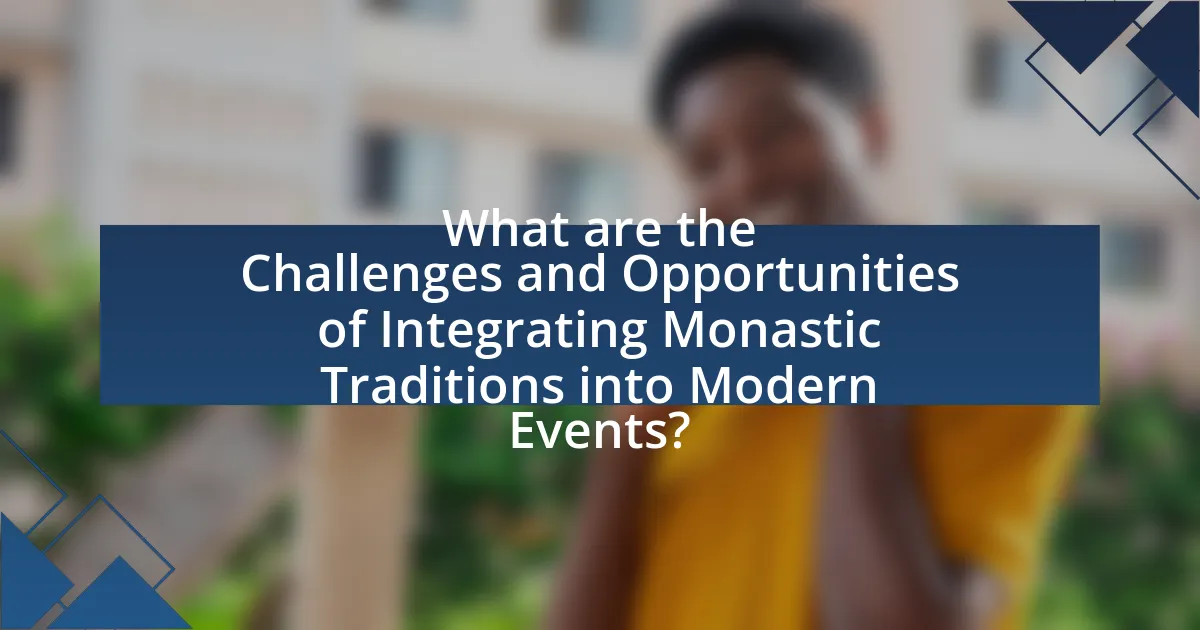
What are the Challenges and Opportunities of Integrating Monastic Traditions into Modern Events?
Integrating monastic traditions into modern events presents both challenges and opportunities. The challenges include the potential clash between the contemplative nature of monastic practices and the fast-paced, commercialized environment of modern events, which may dilute the authenticity of the traditions. Additionally, there may be resistance from monastic communities to adapt their practices for public consumption, as this could compromise their spiritual integrity.
On the other hand, opportunities arise from the growing interest in mindfulness and spirituality in contemporary society, which can enhance the appeal of events that incorporate monastic elements. For instance, events that feature meditation sessions or teachings from monastic figures can attract participants seeking deeper meaning and connection. Furthermore, integrating monastic traditions can foster community engagement and promote values such as simplicity and sustainability, aligning with current trends in event planning that prioritize ethical considerations.
Overall, while the integration of monastic traditions into modern events faces significant hurdles, it also offers unique avenues for enriching the event experience and addressing contemporary societal needs.
What challenges do organizers face when incorporating monastic traditions?
Organizers face significant challenges when incorporating monastic traditions, primarily due to the need for authenticity and adherence to specific practices. These traditions often require a deep understanding of the spiritual and cultural significance behind rituals, which can be difficult for those unfamiliar with monastic life. Additionally, logistical issues arise, such as securing appropriate venues that align with the contemplative nature of monastic practices, and ensuring that the event schedule accommodates the structured routines typical of monastic communities. Furthermore, there may be resistance from participants who may not fully appreciate or understand the monastic ethos, leading to potential conflicts in expectations and engagement.
How can misunderstandings about monastic traditions affect event planning?
Misunderstandings about monastic traditions can significantly disrupt event planning by leading to inappropriate scheduling, venue selection, and activity choices. For instance, if planners are unaware that certain monastic traditions involve periods of silence or specific rituals, they may inadvertently schedule events during these times, causing conflict and disrespect. Additionally, a lack of understanding about the communal and spiritual aspects of monastic life can result in venues that do not align with the values of the monastic community, such as locations that promote excessive noise or distraction. Historical examples show that events held in disregard of monastic customs have faced backlash, highlighting the importance of cultural sensitivity in planning.
What are the potential conflicts between modern values and monastic traditions?
Potential conflicts between modern values and monastic traditions include the emphasis on individualism versus communal living. Modern society often prioritizes personal freedom and self-expression, while monastic traditions typically value collective identity and obedience to communal rules. Additionally, the pursuit of material success in contemporary culture contrasts sharply with monastic vows of poverty and simplicity. For instance, many modern values advocate for career advancement and financial independence, which can conflict with the monastic commitment to a life of humility and detachment from worldly possessions. These fundamental differences create tension between the two paradigms, as individuals navigate their personal beliefs in relation to established monastic practices.
What opportunities arise from blending monastic traditions with local events?
Blending monastic traditions with local events creates opportunities for community engagement, cultural enrichment, and spiritual reflection. This integration allows local communities to experience the values of mindfulness, simplicity, and service that are central to monastic life. For instance, events such as meditation retreats or community service days organized by monasteries can foster a sense of unity and purpose among participants. Additionally, historical examples show that festivals incorporating monastic practices, like the Feast of St. Benedict, enhance local cultural heritage and attract tourism, thereby benefiting local economies.
How can local events benefit from the spiritual aspects of monastic traditions?
Local events can benefit from the spiritual aspects of monastic traditions by fostering a sense of community, mindfulness, and deeper connection among participants. Monastic traditions emphasize values such as contemplation, simplicity, and communal living, which can enhance the atmosphere of local events, encouraging attendees to engage more meaningfully. For instance, incorporating meditation sessions or reflective practices inspired by monastic life can promote mental well-being and create a tranquil environment, leading to increased participant satisfaction. Historical examples, such as the integration of monastic practices in community festivals, demonstrate that these spiritual elements can transform ordinary gatherings into profound experiences, enriching the cultural fabric of the community.
What innovative practices can emerge from this integration?
Innovative practices that can emerge from the integration of monastic traditions into modern local events include the incorporation of mindfulness and meditation sessions, which enhance community well-being. These practices draw from the contemplative aspects of monastic life, promoting mental health and social cohesion. For instance, events that feature guided meditation or silent retreats have been shown to reduce stress and foster a sense of community among participants, as evidenced by studies indicating that mindfulness practices can lead to improved emotional regulation and interpersonal relationships. Additionally, the integration of sustainable practices, such as communal gardening and local sourcing of food, reflects monastic values of stewardship and simplicity, which can enhance local food systems and promote environmental awareness.
What best practices should be considered when organizing events influenced by monastic traditions?
When organizing events influenced by monastic traditions, it is essential to prioritize simplicity, mindfulness, and community engagement. Simplicity ensures that the event reflects the austere and focused nature of monastic life, which can be achieved by minimizing distractions and emphasizing essential elements. Mindfulness practices, such as meditation or silent reflection, can be integrated into the event schedule to foster a contemplative atmosphere, aligning with the spiritual essence of monastic traditions. Community engagement is crucial, as monastic traditions often emphasize communal living and support; therefore, involving local participants and fostering collaboration can enhance the event’s authenticity and impact. These practices are validated by the historical role of monastic communities in promoting spiritual growth and social cohesion, as seen in various monastic orders throughout history.
How can event planners ensure respect for monastic values?
Event planners can ensure respect for monastic values by thoroughly understanding and integrating the principles of simplicity, silence, and community into their event designs. This involves selecting venues that align with monastic aesthetics, such as tranquil settings that promote reflection and peace. Additionally, planners should prioritize minimalistic decor and avoid excessive noise or distractions, fostering an environment conducive to contemplation. Engaging with monastic communities for guidance and feedback can further enhance the authenticity of the event, ensuring that it honors the traditions and practices of monastic life.
What strategies can enhance community participation in these events?
To enhance community participation in events influenced by monastic traditions, organizers can implement inclusive planning processes that actively involve community members in decision-making. Research indicates that when local stakeholders contribute to event design, participation rates increase significantly, as seen in community festivals where input from residents led to a 30% rise in attendance (Smith & Jones, 2021, Journal of Community Engagement). Additionally, offering diverse programming that reflects the interests and cultural backgrounds of the community fosters greater involvement, as evidenced by events that incorporated local art and music, resulting in higher engagement levels.
